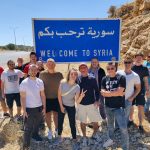Look at different maps and compare the shape of Morocco between them. Chances are you will find that the lines of Morocco are quite different. Sometimes Morocco is double the size of itself on a different map, sometimes a dotted line divides it in half and sometimes a thin sliver between it and Mauritania is marked as Western Sahara.
Western Sahara, or what was supposed to emerge from the decolonization of Spanish Sahara, is a project that never happened. Morocco launched a campaign, the Green March, and claimed it. Nowadays, the local people might be divided when it comes to describing themselves. While some will insist that they are Sahrawis, others are now completely fine with being Moroccans and you will find the same franchises and banks you’d find in Rabat in Laayoune or Dakhla. The currency is the same, the language (while slightly different) is quickly learned by any Arabic speaker and the religion is the same. You will find 5-star hotels as well as McDonald’s and could easily forget you are in a conflicted zone.

There is one place, however, where Western Sahara is nowhere like Morocco — one place that is actually very unique compared to the rest of the world.

Four hours south of Dakhla lies the border of Morocco at Guerguerat. From there, one exits the territory controlled by Morocco but one isn’t yet in Mauritania, the neighboring country. In fact, it could be said that this is where the Democratic Sahrawi Republic starts and isn’t contested. The grim yet extremely interesting scenery starts.
Sellers of stolen cars, weapons and other goods sold outside the reach of any sovereign country’s law line up along the road. In the distance car wrecks, some caused by rolling over the numerous landmines placed in the ground, create a post-apocalyptic scene. Photos are hard to take as the zone is highly militarized and most people here clearly do not appreciate having their portrait taken.
Under the scorching sun, people who do not have international transportation arranged will find a driver to take them from one border to the other, with some people living from doing the back and forth trip continuously in this thin strip of land with neither infrastructure nor laws.

On the road, one can also see slum houses, makeshift havens for Sahrawi refugees who haven’t been integrated into Morocco.

The ride is mesmerizing yet quickly finished. On the other side, another world awaits as the Islamic Republic of Mauritania starts. Much poorer than its northern neighbour and much more militarized, the border of Mauritania gives a bleak first impression. Visitors need to go through the easy yet slow process of getting their visa on arrival. Contrary to what the local fixers offering to help with the formalités may say, a thrifty and independent traveller wishing to save money quickly discovers process only involves showing a passport a bunch of times, paying €55 and waiting for a faulty printer to issue a very poorly printed visa.
From there it is only an hour to Nouadhibou, the second biggest city of Mauritania and, for most, the place where the false impressions given by the border crossing are quickly corrected as people have their first encounter with a country that is truly worth discovering, filled with hospitable and warm people and ancient history. But that is for another time!





